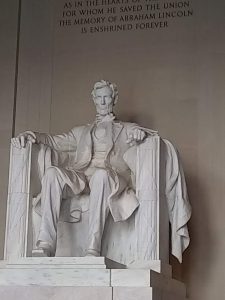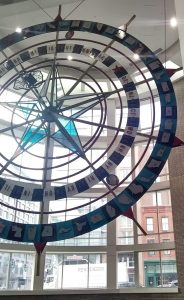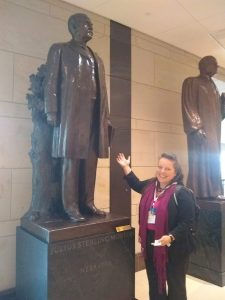A Crisis Response
Like many aspects of life, the World Language Review was put on hold last month as we all struggled to respond to the COVID-19 Crisis. Working with teachers across the state, I am able to see a wide variety of responses to our new world of online teaching. Eventually we will move beyond this crisis. When we do, there will be some important lessons to keep in mind. Having an online presence is no longer an option in education. While most teachers, especially world language teachers, work with technology in teaching, many of us are not comfortable with online communication software, online course content software, and online grading practices. I encourage you to look for resources to support these areas. Some helpful organizations include NETA, Google for Education, and ISTE. While there may still be some things to learn, overall educators throughout the state have responded admirably to this crisis by maintaining a sense of norm and a connection for all of their students.
Stephanie Call, World Languages Specialist ♦ 402-471-4331 ♦ stephanie.call@nebraska.gov
Charlamos: A Crisis Response
Like many aspects of life, the World Language Review was put on hold last month as we all struggled to respond to the COVID-19 Crisis. Eventually we will move beyond this crisis. When we do, there will be some important lessons to keep in mind. Having an online presence is no longer an option in education. While most teachers, especially world language teachers, work with technology in teaching, many of us are not comfortable with online communication software, online course content software, and online grading practices. I encourage you to look for resources to support these areas. Some helpful organizations include NETA, Google for Education, and ISTE. While there may still be some things to learn, overall educators throughout the state have responded admirably to this crisis by maintaining a sense of norm and a connection for all of their students.
Proficiency Goals for WL Programming
One of the most frequent questions asked regarding the 2019 World Language Standards is “What do I have to buy? Should I use this resource or that resource?” I would challenge us to look first at our ultimate goal. What do you want students to be able to do with the language? The Nebraska Seal of Biliteracy is the high honor of proficiency in language learning, celebrating a student’s ability to function for the purpose of academia or career in the language. Districts that want students to qualify for the Nebraska Seal of Biliteracy and other high honors will create programming to support that goal. Use your proficiency goal as the guidance for curriculum and instruction. As we know, proficiency is built through practice, not necessarily materials.
Stephanie Call, World Languages Specialist ♦ 402-471-4331 ♦ stephanie.call@nebraska.gov
Forward Progress on the Nebraska Seal and More
This month celebrates the announcement of the Nebraska Seal of Biliteracy. A collaborative project with the Nebraska International Language Association, the Nebraska Seal of Biliteracy recognizes high school students who have achieved proficiency in English and a language other than English. NILA began this work three years ago, yet this updated Seal reflects the standards of the national Seal of Biliteracy organization and has been streamlined for ease of application and processing. Momentum for World Language learning has certainly begun to grow in Nebraska. A recent review of data submitted by schools showed that 98 % of secondary students in Nebraska are enrolled in a world language course. As the Nebraska Seal rolls out, World Language Week Distinguished Scholar applications get under way, and we continue to move on standards implementation, it’s easy to feel excited for 2020.
K-20 Connections: Building a Personal Stake in Language Learning
Sutton Public Schools Spanish Teacher Dara Rodriguez recently connected her three groups of Spanish 2 and 3 via Skpe with the Department of Modern Langauges at the University of Nebraska Lincoln. Professor Kelly Kingsbury Brunetto, undergraduate students Rebeca Portales de Jacobson and Andrew Holzman, and assistant teachers Lara Armenteros Garrido and Ana Maria Tudela Martinez conversed with Sutton students about the importance of language learning in Nebraska and connections to career paths. Rodriguez initiated the conversation as a way of showing her Sutton students how language learning connects to college and career readiness.
Charlamos: Dialogue in DC
Washington D.C. has both southern hospitality and northern efficiency. From the quick and courteous Uber drivers to the staff at the Capitol Visitor Center, everyone manages to treat each visitor as a guest. This bonhomie carried into the ACTFL Conference and NCSSFL annual meeting as the level of dialogue and discourse truly elevated this event into a policy changing catalyst. Throughout the many meetings, networking quickly developed into opportunities for future collaboration and programming. Already work has begun in response to these conversations. ACTFL D.C. will certainly have a monumental impact in world language programming in Nebraska and throughout the United States.
Charlamos: The Way to Washington
Annually, I attend the National Council of State Supervisors of Foreign Language Annual Meeting and the American Council on the Teaching of Foreign Language Annual Convention. This year’s meeting celebrates NCSSFL’s 60 years of providing leadership in world language teaching and learning across the nation. If you would like to know more about NCSSFL’s work with the Seal of Biliteracy, LinguaFolio, and the Intercultural Can-Do Statements, visit the NCSSFL website at www.ncssfl.org.
KWL-Cognition in Practice
In a unit on body parts and health, students were asked to complete a KWL. These “know, want to know, and learned” activities work well with approaching content outside of strongly familiar topics. Students respond with words, phrases, or sentences about what they already know, what they would like to know, and what they learned. How would you make this look in the target language? Share your ideas.
Note of Appreciation
Thank you to everyone who helped with this process by providing expertise, resources, time and dedication. I look forward to sharing more about the standards at the NILA Conference October 11-12 in Kearney.
Cognitive Benefits of Language Learning
This summer, I traveled to Spain on a scholarship to the University of Valladolid’s professional development seminar for teachers of Spanish. There I met educators from around the world. I was struck by the tendency of world language teachers to be bold, adventurous, adept at wordplay, precise in expression, and creative in problem solving. In fact, I’m convinced that the cognitive structuring from our language studies actually made us better travelers. Every attention was paid to details, comparing, contrasting, problem-solving, and negotiating. Our language learning not presented the ability to communicate in Spain, it awarded us a greater level of understanding and learning from the experience.
Stephanie Call, World Languages Specialist ♦ 402-471-4331 ♦ stephanie.call@nebraska.gov
Have Passport, Will Travel
When Mrs. Moser showed our Spanish Two class photos of Mayan pyramids, I could not imagine myself in such a place. Since then, I’ve been to Mexico, Uruguay, Costa Rica, the Dominican Republic, Canada, and Brazil. Truly, travel is more than the destination. It is the experience, the unexpected, the growth in discovering what you didn’t know you didn’t know. If you’ve been there, you know that sentence isn’t a grammatical error. Traveling with students makes for even more poignant memories. Place names take on extraordinary value. La Fortuna waterfall is where we splashed as the fish darted around us. Teotihuacan is where we conquered the Sun and the Moon in an afternoon. Monteverde is where one conquered his fear of Spanish and chatted with area school children. This summer, remember that travel isn’t impossible. It’s invaluable.
Uruguay’s Take on Global Understanding
In 2007, I participated in a Fulbright exchange to Uruguay with nine other US teachers. At that time, 109 full time schools offered 8 hours of school time and three meals day. 24 of those schools were dual-language English/Spanish or Spanish/Portuguese. Schools did not typically have computers, internet or photocopiers. Yet, Uruguay was willing to think globally. A national team examined problems, consulted with various experts, worked to understand the cultural needs of the communities, and considered sustainability. In 2009, President Tabare Vazquez finalized “Plan Ceibal” which gave laptops to all grade school students and their teachers. Now 319 full time schools offer second language from dual language to immersion. Uruguay continues to think globally as it analyzes its needs and prioritizes how to address them.
Columbus Teacher Deserves Credit
Columbus High School teacher Liliana Velasco has long participated in the University of Nebraska Lincoln’s International Day competitions hosted by UNL’s Department of Modern Languages and Literatures. When UNL announced it would not be possible to host International Day this year, Velasco, saddened by the loss of a valuable opportunity for her students, decided to host her own Spanish Day at Columbus High School. I traveled to Columbus to participate in this event. Although many educators at the school participated in and assisted with making this a wonderful experience, they all credited Liliana Velasco with the drive and determination to motivate, organize, and inspire others. I am in awe of Ms. Velasco. Her talent for inspiring students to become passionate for acting, dancing, singing, and performing in another language and her willingness to step up to create a new venue for language celebration are phenomenal.
The Power of Languages
The Power of Languages came to me when, as a high school student, I participated in a mission trip to Nuevo Progreso, Mexico sponsored by the Bladen/Blue Hill United Methodist Church. My first semester Spanish skills were applied to creating and memorizing a phrase of introduction and an explanation of why I was there. I still remember: “Estoy aquí para construir casas para Mabel.” It worked. One day, I became separated from the work team as we were in downtown Nuevo Progreso. I used my phrase with a nearby vendor who took me to another vendor who led me through the maze of streets to where the workgroup had gathered. In our broken bilingual conversation, I made a human connection and learned more about the incredible impact the program had on the community. That day, even broken language had the power to unite, to inform, and to change perspectives for the better.
Stephanie Call, World Languages Specialist ♦ 402-471-4331 ♦ stephanie.call@nebraska.gov
The Heart in Language Teaching
Personal communication and intercultural connections in the world language classroom are often the attractions to world language learning. Think about the reasons that students want to learn a language: the annual world language soccer game, to communicate with a friend’s family, or to be able to read the YouTube comments to their favorite channel. Supporting intercultural connections breathes life, adventure, and immediacy into language.





